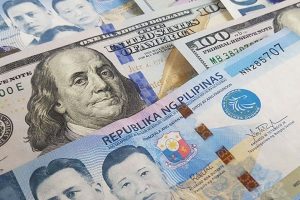THE PHILIPPINE PESO could return to the P59-per-dollar level this year, as the US dollar continues to strengthen, analysts said.
The local unit closed at P58.68 against the greenback on Monday, strengthening by 5.2 centavos from its P58.732 finish on Friday.
“(The Philippine peso) was one of the worst performers in Asia last month, with rate cut expectations by BSP (Bangko Sentral ng Pilipinas) next month adding fuel to the fire,” ING Bank said in a report.
“A move to 59 looks likely, however, further downside in the near term should be limited,” it added.
In October 2022, the peso hit a record low of P59 against the dollar, which led to inflationary pressures and prompted the central bank to intervene.
The incoming Trump administration’s proposals to hike tariffs and impose stricter immigration policies could pose a risk to the peso, a trader said in a phone call.
“The likelihood that it will reach P59 is (due) to the risk of the US tariffs, because that would boost the dollar,” the trader said.
On the other hand, the surge in remittances this upcoming holiday season would support the local currency, the trader said, which would make it unlikely for the peso to go beyond the P59-per-dollar level.
Markets expect the incoming Trump administration to impose trade tariffs and tighten immigration, as well as deepen the deficit, measures deemed to be inflationary, Reuters reported.
Meanwhile, ING said the “upside beyond P59” could be limited due to several factors, such as latest inflation data.
“(The Philippine peso) has historically been vulnerable to inflation risk. With Brent oil price settling in the mid-70s and rice prices correcting noticeably, the trade deficit is likely to remain contained,” it said.
Headline inflation picked up to 2.3% in October, bringing the 10-month average to 3.3%. This is within the central bank’s 2-4% target.
The Bangko Sentral ng Pilipinas (BSP) expects inflation to settle at 3.1% this year, 3.2% in 2025 and 3.4% in 2026.
ING also noted the Philippine central bank’s “historical preference of defending the P59 level.”
BSP Governor Eli M. Remolona, Jr. earlier said the central bank intervenes in the foreign exchange market when necessary to “smoothen excessive volatility and restore order during periods of stress.”
The BSP had to intervene in “small amounts” when the peso fell to the P58-per-dollar level back in May, its first time hitting the level since 2022.
Meanwhile, the peso is also seen to have “relatively low sensitivity to CNY (Chinese yuan) weakness,” ING said.
“In the aftermath of Trump’s election victory and the National People’s Congress (NPC) meeting, the CNY moved weaker from 7.10 to 7.18. The CNY will likely be dragged along by broader dollar trends but should remain a low volatility currency versus other Asian FX,” it said.
FURTHER WEAKENINGOn the other hand, Capital Economics said in a separate report it expects the peso to end the year at the P59-per-dollar level, and further depreciate to P62 in 2025.
It likewise said currencies in Asia in general are at risk due to Mr. Trump’s proposed policies, which will keep US Treasury yields elevated over the coming year and exert upward pressure on the dollar.
“We think Asian currencies will weaken by 3-10% against the greenback between now and the end of next year, with the biggest falls being in the renminbi (since China faces larger tariffs). The risks are tilted towards these moves being even more pronounced.”
“Weaker currencies can push up the cost of imported goods and add to inflationary pressures. But given the weakness of inflation across the region, this is unlikely to be a major concern to policy makers,” it added.
Capital Economics said most Asian countries may even favor weaker currencies to “offset the impact of higher tariffs.” — Luisa Maria Jacinta C. Jocson
